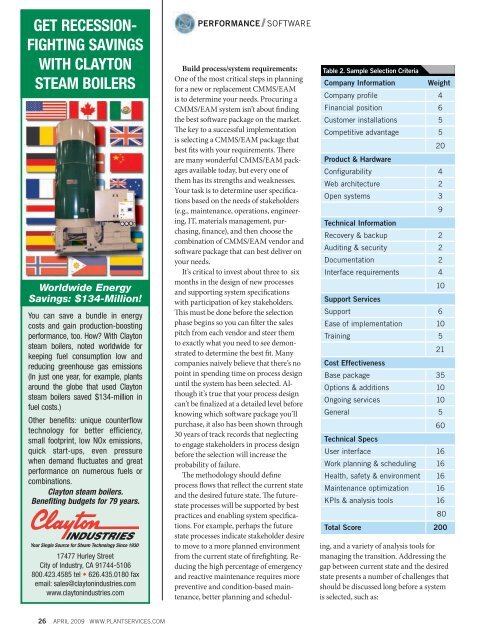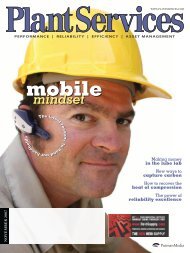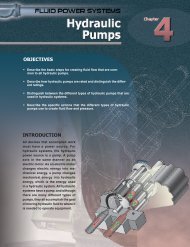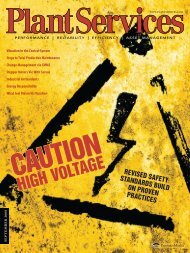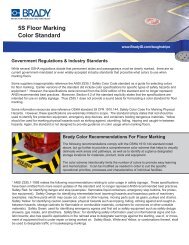POWER UP A WINNER - Plant Services
POWER UP A WINNER - Plant Services
POWER UP A WINNER - Plant Services
You also want an ePaper? Increase the reach of your titles
YUMPU automatically turns print PDFs into web optimized ePapers that Google loves.
GET RECESSION-<br />
FIGHTING SAVINGS<br />
WITH CLAYTON<br />
STEAM BOILERS<br />
Worldwide Energy<br />
Savings: $134-Million!<br />
You can save a bundle in energy<br />
costs and gain production-boosting<br />
performance, too. How With Clayton<br />
steam boilers, noted worldwide for<br />
keeping fuel consumption low and<br />
reducing greenhouse gas emissions<br />
(In just one year, for example, plants<br />
around the globe that used Clayton<br />
steam boilers saved $134-million in<br />
fuel costs.)<br />
Other benefits: unique counterflow<br />
technology for better efficiency,<br />
small footprint, low NOx emissions,<br />
quick start-ups, even pressure<br />
when demand fluctuates and great<br />
performance on numerous fuels or<br />
combinations.<br />
Clayton steam boilers.<br />
Benefiting budgets for 79 years.<br />
17477 Hurley Street<br />
City of Industry, CA 91744-5106<br />
800.423.4585 tel • 626.435.0180 fax<br />
email: sales@claytonindustries.com<br />
www.claytonindustries.com<br />
performance / software<br />
Table 2. Sample Selection Criteria<br />
Company Information Weight<br />
Company profile 4<br />
Financial position 6<br />
Customer installations 5<br />
Competitive advantage 5<br />
20<br />
Product & Hardware<br />
Configurability 4<br />
Web architecture 2<br />
Open systems 3<br />
9<br />
Technical Information<br />
Recovery & backup 2<br />
Auditing & security 2<br />
Documentation 2<br />
Interface requirements 4<br />
10<br />
Support <strong>Services</strong><br />
Support 6<br />
Ease of implementation 10<br />
Training 5<br />
21<br />
Cost Effectiveness<br />
Base package 35<br />
Options & additions 10<br />
Ongoing services 10<br />
General 5<br />
60<br />
Technical Specs<br />
User interface 16<br />
Work planning & scheduling 16<br />
Health, safety & environment 16<br />
Maintenance optimization 16<br />
KPIs & analysis tools 16<br />
80<br />
Total Score 200<br />
Build process/system requirements:<br />
One of the most critical steps in planning<br />
for a new or replacement CMMS/EAM<br />
is to determine your needs. Procuring a<br />
CMMS/EAM system isn’t about finding<br />
the best software package on the market.<br />
The key to a successful implementation<br />
is selecting a CMMS/EAM package that<br />
best fits with your requirements. There<br />
are many wonderful CMMS/EAM packages<br />
available today, but every one of<br />
them has its strengths and weaknesses.<br />
Your task is to determine user specifications<br />
based on the needs of stakeholders<br />
(e.g., maintenance, operations, engineering,<br />
IT, materials management, purchasing,<br />
finance), and then choose the<br />
combination of CMMS/EAM vendor and<br />
software package that can best deliver on<br />
your needs.<br />
It’s critical to invest about three to six<br />
months in the design of new processes<br />
and supporting system specifications<br />
with participation of key stakeholders.<br />
This must be done before the selection<br />
phase begins so you can filter the sales<br />
pitch from each vendor and steer them<br />
to exactly what you need to see demonstrated<br />
to determine the best fit. Many<br />
companies naively believe that there’s no<br />
point in spending time on process design<br />
until the system has been selected. Although<br />
it’s true that your process design<br />
can’t be finalized at a detailed level before<br />
knowing which software package you’ll<br />
purchase, it also has been shown through<br />
30 years of track records that neglecting<br />
to engage stakeholders in process design<br />
before the selection will increase the<br />
probability of failure.<br />
The methodology should define<br />
process flows that reflect the current state<br />
and the desired future state. The futurestate<br />
processes will be supported by best<br />
practices and enabling system specifications.<br />
For example, perhaps the future<br />
state processes indicate stakeholder desire<br />
to move to a more planned environment<br />
from the current state of firefighting. Reducing<br />
the high percentage of emergency<br />
and reactive maintenance requires more<br />
preventive and condition-based maintenance,<br />
better planning and scheduling,<br />
and a variety of analysis tools for<br />
managing the transition. Addressing the<br />
gap between current state and the desired<br />
state presents a number of challenges that<br />
should be discussed long before a system<br />
is selected, such as:<br />
26 APRIL 2009 www.PLANTSERVICES.com


